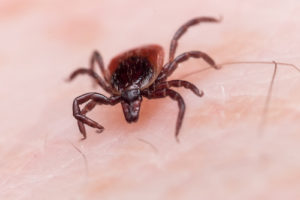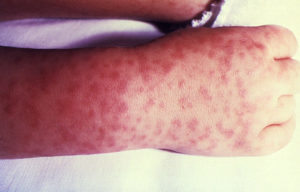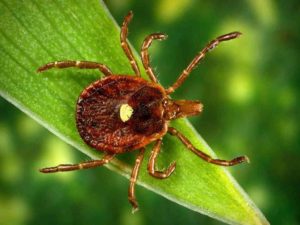 Rocky Mountain Spotted fever (RMSF) is so far not as common in Massachusetts as Lyme disease. This can make it extra dangerous as physicians and patients do not readily know the risks, signs, and symptoms.
Rocky Mountain Spotted fever (RMSF) is so far not as common in Massachusetts as Lyme disease. This can make it extra dangerous as physicians and patients do not readily know the risks, signs, and symptoms.
Usually, RMSF is spread by the dog tick, but it can also be spread by the wood tick and lone star tick. With the lone star tick recently spreading into the Northeast, Massachusetts residents have more chances for transmitting the potentially fatal illness.
What is Rocky Mountain Spotted Fever?
The bacteria Rickettsia rickettsi causes the illness known as Rocky Mountain Spotted Fever (RMSF). Transmitted by the bite of an infected tick, symptoms are non-specific and can include fever, headache, nausea, vomiting, abdominal pain, muscle pain, lack of appetite, red eyes, and a characteristic rash. It is important to remember that the combination of these symptoms will vary from case to case.
 According to the CDC, about 90% of people with RMSF will have some type of rash, but some do not develop it until late in the illness – after treatment should have already begun. Diagnosing RMSF can be delayed if you are waiting for the rash to appear. The CDC recommends that physicians administer treatment with antibiotics if RMSF is suspected. Early treatment is vital to limiting long term effects and avoiding potential death.
According to the CDC, about 90% of people with RMSF will have some type of rash, but some do not develop it until late in the illness – after treatment should have already begun. Diagnosing RMSF can be delayed if you are waiting for the rash to appear. The CDC recommends that physicians administer treatment with antibiotics if RMSF is suspected. Early treatment is vital to limiting long term effects and avoiding potential death.
Late diagnosis and treatment can result in long-term health problems. The infection affects the cells that line the blood vessels. Damage to those blood vessels can cause bleeding or clotting in the brain or other vital organs. A loss of blood flow to the extremities can also occur leading to potential amputations of fingers, toes or limbs. Long-term permanent neurological effects and damage to internal organs can occur if this type of vascular damage occurs.
RMSF Can Be Deadly if Not Treated – Tick Control is Essential

Case fatality rates for Rocky Mountain Spotted fever are improving. It is suspected that improved recognition and diagnostics have led to quicker treatment and the decline in death rates. The CDC reports a 28% case fatality rate in 1944 that has lowered to approximately 1% in 2001. Children under 10-years-old, American Indians and those with compromised immune systems are at an increased risk for a fatal outcome from RMSF. The National Center for Biotechnology Information says “a delay in administration of doxycycline, the recommended drug of choice, has been shown to increase the likelihood of [a] fatal outcome.”
A recent story in the Cape Cod Times chronicled the story of a 6-year-old girl who came all too close to losing her life as she and her family struggled to get a diagnosis of her severe ailment. First diagnosed as a sinus infection and then an allergic reaction to the treatment, it wasn’tasn’tl Alaina was sent by MedFlight to Boston Children’s Hospital that she was finally diagnosed with RMSF after a few days. Suffering from meningitis and meningoencephalitis, Alaina has recovered, but it was a long road.
This is a great summation of why I work diligently to educate our community. Simply knowing the risks for exposure and the variety of symptoms to watch for can save a life. Can save many lives. Make sure you know the symptoms of RMSF and tell your doctor immediately if you suspect it.